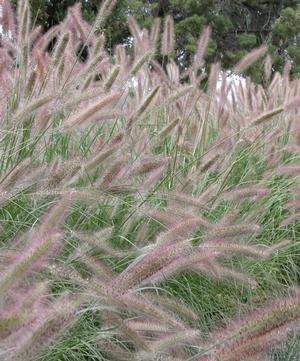Printed at http://www.newmoonnursery.com/index.cfm/
Pennisetum alopecuroides
Fountain Grass
Native to China
FIRST IMPRESSIONS: Pennisetum alopecuroides is a clump forming warm season grass with graceful arching foliage. Leaves are deep green, narrow and sharply pointed. In late summer culms are tipped with silvery bottlebrush like flowers. The flowers arch from the clump giving the plant a fountain-like appearance. Foliage develops golden yellow fall color before assuming a soft beige winter color. This handsome Asian grass thrives in sunny exposures with moist to wet soils.
HABITAT & HARDINESS: Pennisetum alopecuroides is indigenous to grasslands, open woods, wastelands and wetlands of Eastern Asia including Korea, Japan and the Philippines. The plant may also occur in Western Australia.
According to the USDA, this species has naturalized in a few scattered counties in Illinois, Ohio, Pennsylvania, New York, Arkansas and North Carolina. Plants have been known to escape into grasslands, fields, ditches, edges of swamps and roadsides.
Pennisetum alopecuroides is hardy from USDA Zones 5-9.
PLANT DESCRIPTION: Pennisetum alopecuroides is a robust bunch grass that produces many vertical culms from short rhizomes.
The linear leaves are arranged in a dense rosette and alternately on green culms. The arching sharply pointed blades are smooth, 1/4” wide and up to 20” long.
In late summer as the foliage reaches mature height, spike-like panicles appear. The panicles have a dense bristly bottlebrush form. They are silvery with yellow pollen and usually tinged with pink.
At maturity each spikelet contains one almond colored grain. The dried bristly flowers and foliage have a soft beige winter color. In warm climates, however, foliage is evergreen.
Plants are anchored by an extensive fibrous root system while top growth attains a 3-4’ height and 3’ spread.
CULTURAL & MAINTENANCE NEEDS: Pennisetum alopecuroides prospers in sunny sites with average to moist soil. Plants tolerate part sun, clay, heat, drought, salinity and seasonal flooding.
Avoid excessive shade, fertilizers or water as these conditions promote weak sprawling stems. In northern zones, plants should be sited in protected areas.
Winter seedheads contribute little ornamental value since they usually shatter and disperse early in the season. Since self-seeding can be a problem, plants should be deadheaded in autumn before seed mature.
In most cases, the only other maintenance needed is to cut or burn this grass to the ground in late winter.
Plants are relatively pest free but young foliage is grazed by livestock, deer and other herbivores.
LANDSCAPE USES: This grass is an appealing Accent or Mass Planting that provides Erosion Control, Fall Color, Winter Interest, Cut Flowers and Attractive Blooms. Pennisetum alopecuroides is appropriate for Coastal Gardens, Cottage Gardens, Low Maintenance Plantings, Water Wise Landscapes, Rain Gardens, Edges of Water Gardens and Perennial Borders.
COMPANION & UNDERSTUDY PLANTS: Try pairing with Aster novae-angliae ‘Purple Dome’, Coreopsis tripteris, Echinacea purpurea, Nepeta ‘Walker’s Low’, Liatris spicata or Rudbeckia fulgida ‘Goldsturm’.
Pennisetum alopecuroides ‘Hameln’ offers similar appearance and cultural needs. ‘Hameln’ is shorter (to 2 ½’), earlier blooming and cold hardy only to zone 6, however. Carex muskingumensis could provide similar foliage texture, height and habit for a native plant garden.
TRIVIA: The generic name Pennisetum is from the Latin penna or feather and seta or bristle in reference to the feathery bristled flowers. The specific epithet is due to the plant’s resemblance to Alopecurus spp. (a Eurasian foxtail grass).
Height:
3-4 ftSpread:
3 ftSpacing:
4 ftUSDA Hardiness Zone:
5-9Bloom Color:
GreenPennisetum alopecuroides Characteristics
Attracts Wildlife
- Butterflies
Attributes
- Rain Garden
- Naturalizing
- Interesting Foliage
- Dried Flower
- Coastal
- Bog
Exposure
- Full Sun
- Partial Shade to Full Sun
- Full Sun to Partial Shade
- Light Shade
- Sun/Light Shade
Flowering Months
- September
- August
- October
Foliage Color
- Green
Grass Season
- Warm Season Grass
Growth Rate
- Fast
Season of Interest (Foliage)
- Fall
- Summer
- Spring
- Winter
Soil Moisture Preference
- Moist to Wet
- Wet
- Moist
- Wet to Moist
- Moist/Well-Drained

